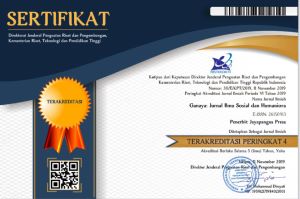Model Komunikasi Pariwisata Taman Nasional Bali Barat Pada Era New Normal Berbasis E-Tourism
DOI:
https://doi.org/10.37329/ganaya.v6i4.2672Keywords:
Tourism Communication Model, Ecotourism, TNBBAbstract
This study aims to determine how the tourism communication model of the West Bali National Park (TNBB) in the era of new normal habits. This study uses qualitative methods with observations and interviews conducted to identify Tourism Communication models to support tourism strategies in the era of new normal habits. The results of this study are the TNBB Tourism Communication Model in the New Normal era using a strategy that is not aggressive in nature, this is because the TNBB business entity itself is under the Ministry of Culture and Tourism, so that what is done is more on managing the tourist park area. Although not persuasive in its marketing communication strategy, TNBB still communicates tourism through their social media. Researchers also suggest a tourism communication strategy by collaborating the concept of ecotourism with digital technology. The concept of technology-based ecotourism will be one of the novelties in terms of TNBB tourism communication to outsiders or visitors. This concept can be done by improving the official website to be more interactive, providing virtual tours for tourists who may not yet be able to come directly to TNBB.
References
Barker, M. J. (2009). Ecotourism as an alternative to mass tourism: A case study of Rara Avis, Costa Rica. In A. Rhama (2019). Peran Ekowisata dalam Mengurangi Dampak Perubahan Iklim di Taman Nasional Gunung Merapi. Bioma, 21(1), 69-78.
Bungin, B. (2015). Komunikasi Pariwisata: Strategi Promosi dan Penyelenggaraan Event Pariwisata. Prenada Media.
Bungin, B. (2015). Komunikasi Pariwisata. Jakarta: Prenada Group.
Creswell, J. W. (2013). Research design: Qualitative, quantitative, and mixed methods approach (4th ed.). USA: Sage Publications.
Filep, S., Laing, J., & Csikszentmihalyi, M. (2017). Positive tourism. Routledge.
Gössling, S., Scott, D., & Hall, C. M. (2015). Tourism and water: Interactions, impacts and challenges. Channel View Publications.
Hall, C. M., & Page, S. J. (2014). The Geography of Tourism and Recreation: Environment, Place and Space. London: Routledge.
Hall, C. M. (2017). Tourism And Regional Development: New pathways. Routledge.
Herdiansyah, H. (2014). Metode Penelitian Kualitatif Untuk Ilmu-Ilmu Sosial. Jakarta: Salemba Humanika.
Jung, T., Chung, N., & Leue, M. C. (2015). The determinants of recommendations to use augmented reality technologies: The case of a Korean theme park. Tourism Management, 49, 75-86.
Kotler, P., Kartajaya, H., & Setiawan, I. (2017). Marketing 4.0 (Moving from Traditional to Digital). New Jersey: John Wiley & Sons, Inc.
Kotler, P., & Keller, K. L. (2009). Manajemen Pemasaran Edisi 8 Jilid 1. Jakarta: Penerbit Erlangga.
Koens, K., Postma, A., & Papp, B. (2018). Is overtourism overused? Understanding the impact of tourism in a city context. Sustainability, 10(12), 4384.
Kristiana, Y. (2019). Buku Ajak Studi Ekowisata. Yogyakarta: Deepublish.
Leask, A., Fyall, A., & Barron, P. (2013). Generation Y: Opportunity or challenge – Strategies to engage Generation Y in the UK attractions’ sector. Current Issues in Tourism, 16(1), 17-46.
Misdrinaya, M. (2017). Strategi Pemasaran Dinas Pariwisata Kota Makasar Dalam Meningkatkan Kunjungan Wisatawan Mancanegara Kota Makasar. Universitas Islam Negeri Alauddin; Makasar. Pp. 26-29.
Nugraha, A. R., Perbawasari, S., & Zubair, F. (2017). Model Komunikasi Pariwisata yang Berbasiskan Kearifan Lokal (Studi Deskriptif Kualitatif di Wilayah Lembang Kabupaten Bandung Barat). Jurnal The Messenger, 9(2), 231-240.
Rachmawati, E., Muntasib, H., & Sunkar, A. (2011). Interaksi sosial masyarakat dalam pengembangan wisata alam di kawasan Gunung Salak Endah. Jurnal Forum Pascasarjana, 34(1), 23–32.
Rakhmat, J. (2009). Metode Penelitian Komunikasi. Bandung: PT Remaja Rosdakarya.
Rhama, B. (2019). Taman Nasional dan Ekowisata. Yogyakarta: Kanikus.
Ritchie, B. W., & Jiang, Y. (2019). A review of research on tourism risk, crisis and disaster management: Launching the annals of tourism research curated collection on tourism risk, crisis and disaster management. Annals of Tourism Research, 79, 102812.
Sigala, M. (2020). Tourism And Covid-19: Impacts, Responses And Outcomes. Goodfellow Publishers.
Soemanagara, R. (2012). Strategi Marketing Communication: Konsep Strategis dan Terapan. Bandung: Alfabeta.
Suwena & Widyatmaja. (2010). Pengetahuan Dasar Ilmu Pariwisata. Bali: Pusaka Larasan.
The Organisation for Economic Co-operation and Development (OECD). (2020). Tourism Policy Responses to the coronavirus (COVID-19). Retrieved from https://www.oecd.org/coronavirus/policy-responses/tourism-policy-responses-to-the-coronavirus-covid-19-6466aa20/
Wober, K., & Gretzel, U. (2016). Transforming travel information to knowledge–tourism 3.0. e-Review of Tourism Research, 13(6), 178-182.
World Travel & Tourism Council. (2020). Economic Impact Report: Indonesia. World Travel & Tourism Council.
Young-Sook Lee, L. J. Lawton, & D. B. Weaver. (2013). Evidence for a South Korean Model of Ecotourism. Journal of Travel Research, 52(4), 520–533.
Yusuf, M. A. (2014). Metode Penelitian Kuantitatif, Kualitatif, Dan Penelitian Gabungan. Jakarta: Penerbit Kencana.
Downloads
Published
How to Cite
Issue
Section
License
Copyright (c) 2023 Wayan Weda Asmara Dewi, Wifka Rahma Syauki, Primadiana Yunita, Fadil Rizky (Author)

This work is licensed under a Creative Commons Attribution-ShareAlike 4.0 International License.
An author who publishes in the Ganaya : Jurnal Ilmu Sosial dan Humaniora agrees to the following terms:
- Author retains the copyright and grants the journal the right of first publication of the work simultaneously licensed under the Creative Commons Attribution-ShareAlike 4.0 License that allows others to share the work with an acknowledgement of the work's authorship and initial publication in this journal
- Author is able to enter into separate, additional contractual arrangements for the non-exclusive distribution of the journal's published version of the work (e.g., post it to an institutional repository or publish it in a book) with the acknowledgement of its initial publication in this journal.
- Author is permitted and encouraged to post his/her work online (e.g., in institutional repositories or on their website) prior to and during the submission process, as it can lead to productive exchanges, as well as earlier and greater citation of the published work (See The Effect of Open Access).
Read more about the Creative Commons Attribution-ShareAlike 4.0 Licence here: https://creativecommons.org/licenses/by-sa/4.0/.








